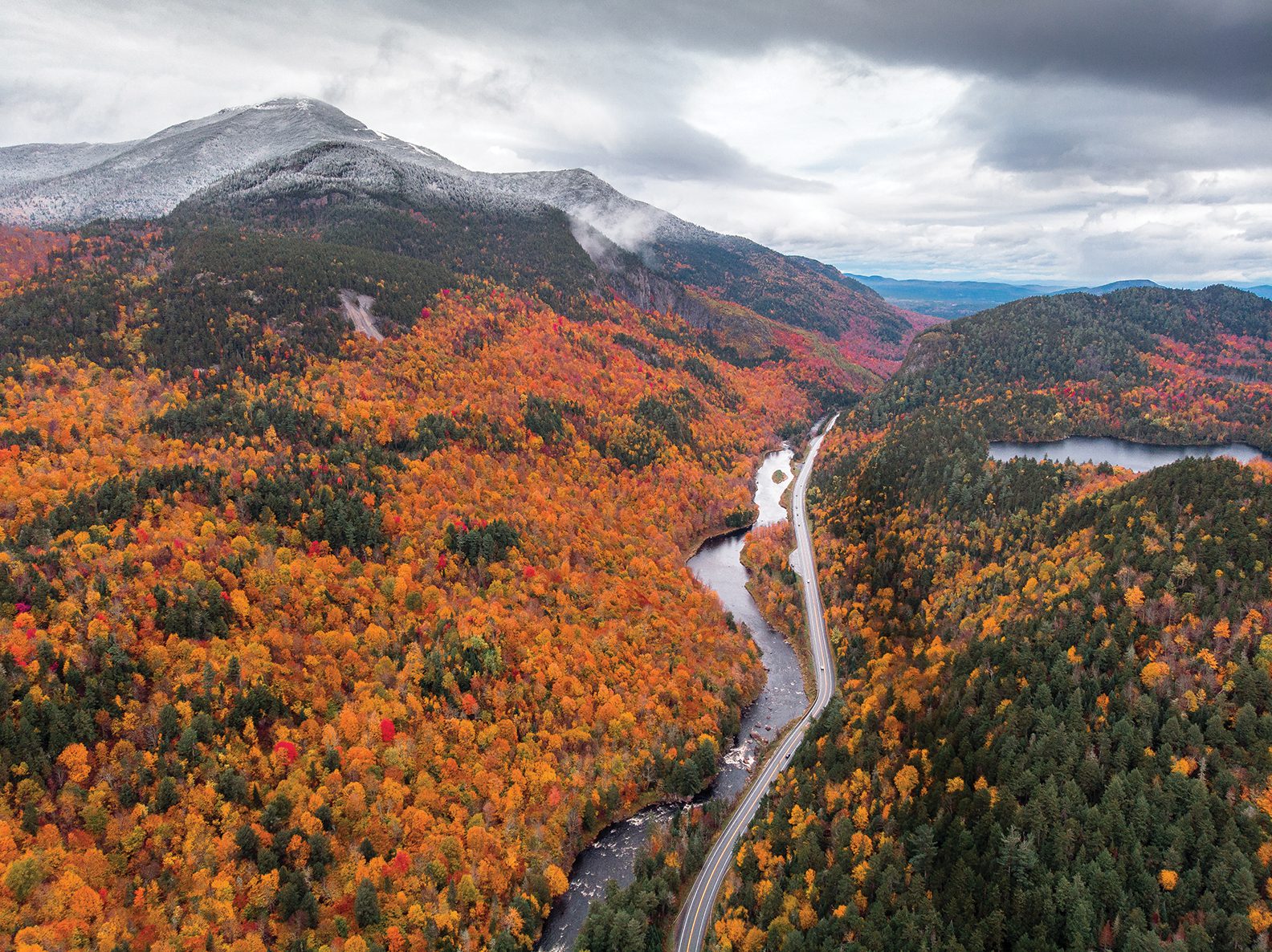
30 Apr Maples, Miracles and Mountains
Far from the rugged high country of the American West, the Adirondacks offer an impressive array of activities and challenges for any outdoor enthusiast
There’s a rich, hilarious vein of #HikeTok TikTok videos skewering Western hikers on their first visit to the Adirondack Mountains in eastern Upstate New York.
The bit goes something like this: A Westerner poo-poos the “little” Adirondacks, which top out just over 5,300 feet. We scale Mount Whitney, climb Colorado’s 14ers in one morning and take on stratovolcanoes. These peaks are child’s play.
Then, horror. The Westerner realizes that here, in the supposedly civilized “back East” there are no switchbacks to ration steep climbs into digestible chunks. Hikes point straight up to the top from the parking lot.
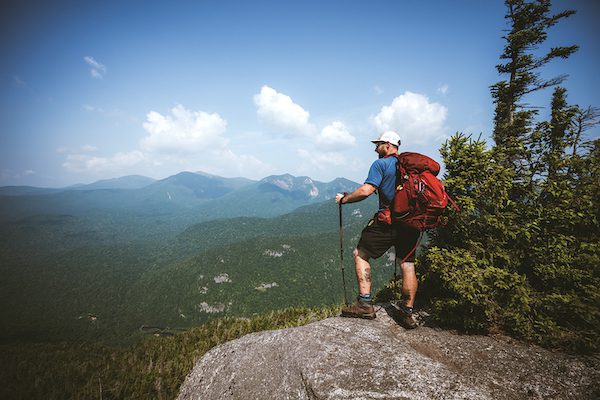
Author James Appleton on Big Slide Mountain, one of the Adirondack High Peaks, courtesy photo
“When I meet people from the West Coast, they’re like, ‘I had no idea (the Adirondacks) were so rugged!’” says James Appleton, a mountain guide and author based in Lake Placid, New York, at the heart of the range.
Appleton hosts the 46 of 46 podcast, which discusses and derives its name from the Adirondacks’ 46 high peaks, which are all above 4,000 feet.
“I’ve been out West, been to Lake Tahoe, and I’ll tell you I prefer this,” he says. “I like to breathe hard and sweat from the start of a hike.”
The trails, which sometimes follow drainages to the top of a ridgeline, represent a more “primitive” style of trail-building, Appleton says, that disregards erosion and the hiker’s legs and lungs.
But, it’s one of the range’s many charms. Once used to getting most of a vertical climb done in the first half-hour on the trail, a world of peak-bagging awaits throughout both the Lake Placid area with its nine high peaks and the range writ large with its numerous other trailways.
Beyond being a hiker’s paradise, the Adirondacks are a conservationist’s dream, a beer lover’s playground and the only place on earth where people can actually skate at the same rink where the 1980 USA men’s hockey team won the Miracle on Ice game.
Upstate Empire
The Adirondacks are mostly encompassed by Adirondack Park.
It comprises public lands owned by New York State and private inholdings covering about 6 million acres. It dwarfs every other park in the contiguous United States, state or federal.
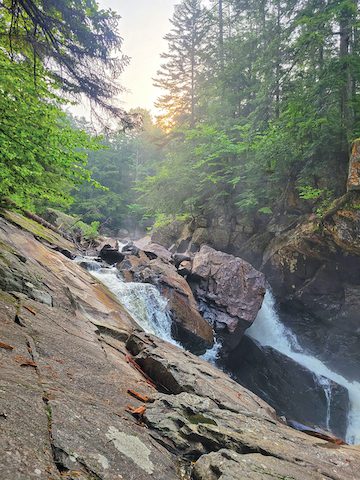
Auger Falls near Speculator, New York, photo by Kyle Magin
For scale, Adirondack Park (ADK to locals) could comfortably house two Death Valleys, or Yellowstone, Yosemite, Kings Canyon, Sequoia and Joshua Tree national parks combined.
Once home to the Seneca, Mohawk and other regional indigenous populations before European colonization, it now has a year-round population of about 130,000 people.
The park’s story began in 1892, serving dual purposes:
One, post-Civil War New York City had grown from 815,000 in 1860 to 3.4 million by 1900. Timber barons denuded much of the primeval forests that covered the Eastern U.S to build it.
Fearing more destruction to the landscape and needing a place to take a break from the big city—trains had by then connected the metropolis to the Adirondacks by rail in about 6.5 hours—New York’s legislature declared all holdings in the area a park.
Two, the chopping of those forests had come at a terrible cost to New York’s drinking water. The city—watered primarily by the Hudson River, which flows from the Adirondacks—needed vast amounts of clean fresh water for its population and commerce, so the park made sense economically even as it closed some areas to development.
“The Adirondacks are the Alaska of redemption, a second-chance Eden,” says Bill McKibben, an author and environmental advocate who has written extensively about the park. “No place on earth has more fully recovered from environmental devastation, all because people, led by the legislature of New York, were willing to take a step back. A renewed forest stepped forward into the void.”
Bagging Peaks
Getting a good view of that environmental success story is one of the great joys of spending time in ADK.
On a 2023 spring trip with my dog Madden, after getting over the shock of the Adirondacks’ particularly aggressive trail system, we thoroughly enjoyed hiking up to old fire lookouts and vistas overlooking a small handful of the park’s 2,800 lakes.
“The culture in the Northeast is peak-bagging,” says Appleton, using the term to mean hiking for the sole purpose of ascending to a peak to catch its views. “There’s some backpacking here, and thousands of miles of trails, but everybody comes to get the 46. It’s about the challenge.”
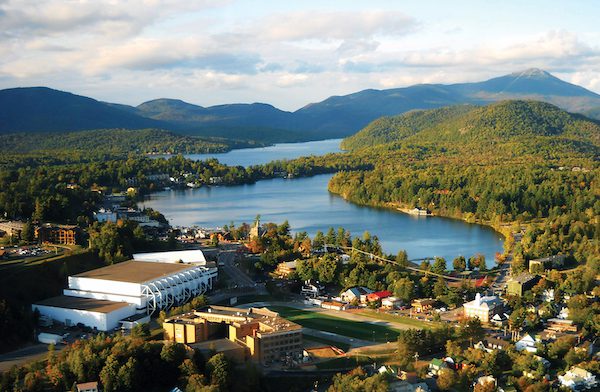
Lake Placid, New York, site of the 1932 and 1980 Winter Olympics, photo courtesy Regional Office of Sustainable Tourism
Despite growing up in the Adirondacks, Appleton, like many small-town kids, didn’t really appreciate the park until he left.
After spending time in the outdoors elsewhere, “I was like, ‘Hold up, I love all of this stuff and I’ve got it at home,’” Appleton says. The realization brought him back to Lake Placid, where he’s cataloged each of the 46 high peaks on his podcast and in a 2021 book, From 1 to 46: A Complete Guide to Climbing the 46 High Peaks.
Appleton’s advice to Adirondack hikers? Start early. Trailhead parking is notoriously limited in the park (another #HikeTok trope) and the early bird gets the worm. Also, there’s nothing like catching a sunrise when you’re already deep into nature, he says.
“Miles in the dark don’t count,” Appleton says. “When you’re two hours in and the sun’s coming up, the miles just evaporate. It’s like the beginning of a new day.”
The park’s high peaks are generally on its eastern side, where the land rises gradually from the west and then falls away suddenly toward lakes George and Champlain, which mark the limit of the park and New York’s border with Vermont, respectively.
Other recreational activities include fly-fishing, canoeing and kayaking, cycling, mountain biking and hunting. In winter, snowshoeing, snowmobiling, skiing, snowboarding and ice skating are popular with the locals, who don’t mind a subzero day.
Adirondack Craftsmanship
After all that recreating—or if waiting out a summer afternoon storm—it’s best to debrief over a cold beer.
Town after town in the Adirondacks, from one-stoplight burgs like Speculator (population 406) to the metropolis of Lake Placid (population 2,250), hosts a brewery or two, perfect for just such occasions.
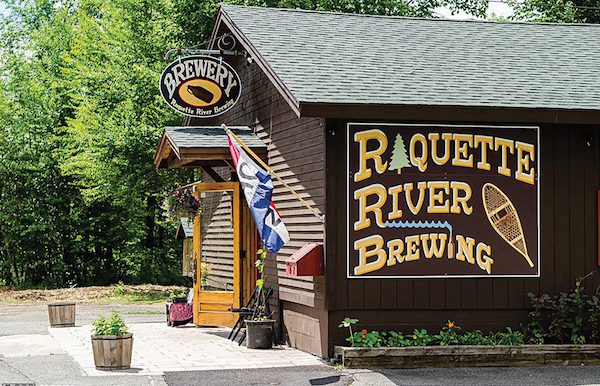
Raquette River Brewing, courtesy photo
In the town of Tupper Lake, you’ll find Raquette River Brewing. It was founded in 2013 by Mark Jessie and Joe Hockey, two former prison guards who decided brewing beer was a lot more fun.
Started as a hobby in Jessie’s Tupper Lake kitchen and garage, the business has since ballooned from a four-barrel operation to 180, a 500-square-foot building to a 3,000-square-foot beer hall, and beers that were only available on tap to cans on shelves as far away as Buffalo, New York. Jessie and Hockey also recently opened a small tap room in Lake Placid to tap into the high volume of tourist traffic there.
“A thing that’s really cool here is in the summer, when a storm rolls in, all of sudden you’ll see all these cars with kayaks on the roofs pull into the lot. Pretty soon we’re filled up with paddlers, hikers, everybody waiting out the rain,” Jessie says.
The brewery is named for the Raquette River, once known as the “Highway of the Adirondacks” as locals trafficked goods up its waters, which flows north to the St. Lawrence River at New York’s border with Canada.
Kevin Connell, a brewer at Raquette, looks every bit the part. Bearded and bespectacled, he takes a scientist’s interest in his craft, which he started honing before turning 21.
“I figured if I couldn’t buy beers, I should be able to make them,” Connell says with a laugh.
He visited the brewery first in 2015 and knew he wanted to work there.
“I fell in love with the place,” says Connell. “I thought it would be a great place to dip my toe into the craft brewing industry.”
Connell counts among his favorite brews at Raquette the Mango Wheat Ale and its New England-style IPAs, which are something of a common sight on menus across the Adirondacks. Emphasizing a hoppier aroma, they are the East Coast’s answer to West Coast IPAs.
Another standout beer on Raquette’s menu is the Maple Cream Porter, which is flavored with maple syrup harvested at nearby Trout Lake.
“It’s a great beer for us to have on tap,” Jessie says. “Not everybody has maple syrup, so it’s a good one for tourists.”
Other regional breweries worth visiting include Plattsburgh Brewing Company and Lake Placid Pub & Brewery.
Miracles, Past and Present
For those who know nothing else about the Adirondacks, there’s a good chance they’ve seen one shiny sliver of the region on TV or film.
Lake Placid hosted the 1980 Winter Olympics, and arguably the most iconic moment in the history of the rings: the semifinal ice hockey game between the U.S. and Soviet Union.

The Miracle on Ice moment in 1980, when Team USA hockey beat the USSR in an Olympic semifinal in Lake Placid, New York, photo courtesy Lake Placid Olympic Museum
Powered by the indomitable coach Herb Brooks and a bunch of college kids, the U.S. took out a heavily favored Soviet team 44 years ago on their march to a gold medal.
Al Michaels, calling the game on TV for ABC, uttered the famous line: “Do you believe in miracles!? Yes!” as the final seconds ticked away.
For $15 ($12 for kids and seniors), visitors can skate on that same ice, now called the 1980 Herb Brooks Arena.
It’s one of the five Olympic Heritage sites preserved and maintained by the Olympic Regional Development Authority, an arm of New York State. The authority is charged with keeping the legacy of the Games—plural, since Lake Placid also hosted the 1932 Winter Olympics—alive.
“We say 1932 put us on the sports map, and 1980 put us on the destination map,” says Darcy Norfolk, director of communications for the Olympic Regional Development Authority. “We’ve been pretty good about ensuring the Olympic legacy stays relevant here.”
To that end, the state has invested in renovating Lake Placid’s aging Olympic venues over the last eight years, which include a bobsled and skeleton track, ski jump, the outdoor speedskating oval, indoor ice arenas and Whiteface Mountain, which hosted downhill skiing, as well as biathlon and cross-country skiing venues.
As a result, the venues frequently host world-class events like World Cup competitions and major hockey tournaments.
“Wherever you go around here, you’re going to be inspired,” says Norfolk. “You might take the gondola up with ski jumpers, or see bobsledders at the track. It’s one thing to hear the old stories; it’s another thing to see the living legacy.”
Included in that legacy is a downtown museum connected to the Herb Brooks Arena commemorating the 1980 Games. Plop down in a seat at the Miracle exhibit to watch a recording of the final seconds as if you were there.
Happy Trails
About an hour’s drive east of Lake Placid is Essex, New York.
That’s where my Adirondack journey ended last spring, on the car ferry across Lake Champlain headed to Vermont.
With my dog happily focused on the Green Mountain State ahead of us from his passenger seat perch, I took one last look back at the Adirondacks and gasped. The view improves with distance, growing to dominate the lake’s western shore.
It’s a region filled with unique sights, tastes, activities and people.
My legs ached in a good way from blasting straight up the mountains all week. My cooler was full of beers not found anywhere else in the world. And my head was full of memories of Olympics past, imagining snow covering the deep green landscape.
Kyle Magin is a writer based in Durham, North Carolina. He watched Miracle immediately after writing this piece.




kim Bombard
Posted at 06:40h, 01 MayI remember watching the hockey miracle while working at a restaurant. the energy of all the customers enthralled by the little TV above the bar!
It was trilling. We in Vermont are lucky to view the Adirondack’s from across lake Champlain ,I appreciate knowing more about them .